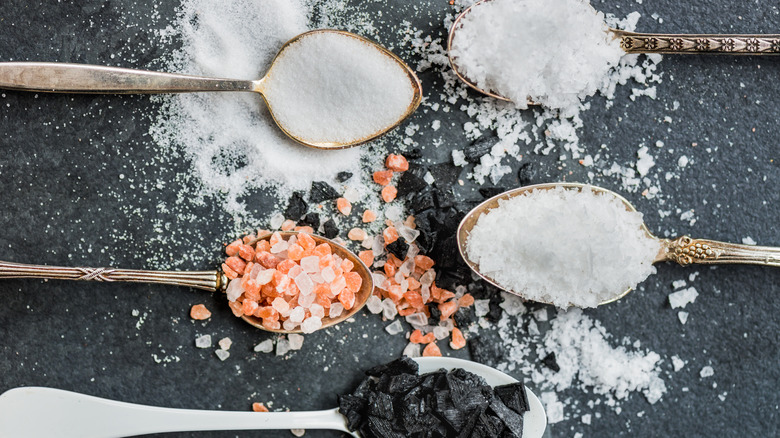You'll Always Find This One Staple Ingredient In 3 Forms In Ina Garten's Pantry
Ina Garten doesn't take any chances when it comes to salt. The right salt can balance and enhance flavors, while the wrong one can result in an unpleasant mouthful. But with at least 16 different types of salt, it can be hard to narrow down in your pantry. Kosher salt, Maldon flaked sea salt, and French sea salt are The Barefoot Contessa's go-tos (via YouTube).
There's a good chance that you also reach for Kosher salt in your cooking. It has a signature flaky, slightly coarse shape to it, and is an unrefined salt that's mined on land. Its size and texture make it easy to measure and cook with, and the fact that it contains no impurities or additives means that it has a much subtler taste than other types.
French sea salt, otherwise known as fleur de sel, is actually one of the most expensive types of salt around. This is largely due to its labor-intensive collection method and the low quantities in which it is produced. Fleur de sel is the natural byproduct of evaporated seawater, forming a thin crust of flaky salt, which means it's got to be harvested by hand. Its texture is finer than regular sea salt but coarser than iodized table salt. Ina Garten likes it for its "lightly briny flavor" (per YouTube).
The last salt staple for Garten is Maldon sea salt flakes. This particular variety of sea salt comes from the British town of Maldon, where one family has been hand-harvesting it since 1882. Maldon salt has a pyramid shape, making it flaky yet not overly coarse. It is decidedly less salty than other sea salts, and its unique harvesting method gives it a slightly sweet taste.
How to use each salt
Each variety of salt can add a different feature to your dishes, so much so that there are at least 10 salts you should always keep in your pantry. Even with just these three, it's important to know the best way to use them.
Kosher salt is excellent for a variety of uses. It's a top choice for seasoning meats before smoking them, as the texture of the salt allows it to melt into the meat and allows for even smoking. Kosher salt is also used for seasoning vegetables and meats for the same reasons; it has a relatively mild salty taste that imbues into the food, rather than sitting on top of it. Remember, even the best salts still need to be seasoned at a distance from proteins to ensure an equal distribution.
Both Maldon and Fleur de sel are finishing salts. This means that they aren't typically used in the cooking process itself, usually because their flavors and physical composition are too delicate. If cooking with finishing salts, the flavors will likely be lost among the other ingredients, and you would need a far larger amount compared to regular table or kosher salt. Rather, these varieties are perfect for enhancing the finished product. Their flaky, soft textures melt in your mouth and provide a small burst of saltiness. This works well with savory dishes like steaks or roasted potatoes, and even with sweet treats. A dash of finishing salt on top of a decadent hot chocolate offers the perfect balance of sweet and salty.


